Relationship between Joint Roughness Coefficient and Statistical Roughness Parameters and Its Sensitivity to Sampling Interval
Abstract
1. Introduction
2. Material and Methods
2.1. Digitization of Barton’s Roughness Profiles
2.2. Joint Sample Preparation
2.3. Joint Sample Digitization
3. Determination of JRC Using Statistical Roughness Parameters
3.1. Study on the Correlation between Statistical Roughness Parameters and JRC
3.2. Determination of JRC Using Statistical Roughness Parameters
4. Correlation between Statistical Roughness Parameters and Sampling Interval
5. Influence of Sampling Interval on Reconstructed Rock Joint Profile
6. Conclusions
- It is observed that there is a good correlation between JRC and statistical roughness parameters Z2, SF, Rp, δ, σi, θ, Ra, Rq, Rz and λ based on the correlation analysis of JRC with statistical roughness parameters with Pearson’s correlation coefficient (γ) method. The coefficient γ values for these roughness parameters exceed 0.7 except for Ra where γ = 0.66. Compared with the amplitude parameters Ra, Rq, Rz and λ (γ ranges from 0.66 to 0.8), a better correlation exists between the textural parameters Z2, SF, Rp, δ, σi and θ and JRC (γ > 0.9).
- Among these parameters, the standard deviation of the roughness angle σi has the strongest correlation with JRC (γ = 0.9923). Further, a linear empirical equation between JRC and the parameter σi is proposed to determine the JRC of the rock joint profile.
- As the sampling interval increases, the Z2, Rp, δ, σi and θ parameter values decrease, and the Ra, Rq, Rz and λ parameter values show slight fluctuations, whereas SF values increase with an increase in the sampling interval. In addition, the evolution in the texture parameters Z2, SF, Rp, δ, σi and θ with the sampling interval can fit a power-law function well.
- Sensitivity analysis has revealed that the texture parameters (Z2, SF, Rp, δ, σi and θ) significantly depend on the sampling interval as a whole. In contrast, the dependence of the amplitude parameters (Ra, Rq, Rz and λ) on the sampling interval is not significant.
Supplementary Materials
Author Contributions
Funding
Institutional Review Board Statement
Informed Consent Statement
Data Availability Statement
Conflicts of Interest
List of Symbols
| JRC | Joint roughness coefficient |
| Z2 | Root mean square of the first derivative |
| SF | Structure function |
| Rp | Roughness profile index |
| Rz | Peak asperity height |
| Ra | Arithmetic average of the absolute height |
| Rq | Root mean square roughness height value |
| θ | Average roughness angle |
| σi | Standard deviation of the roughness angle i |
| λ | The ultimate slope |
| δ | Profile elongation index |
| θ*max | Angular threshold |
| D | Fractal dimension |
| γ | Pearson’s correlation coefficient |
| SI | Sampling interval |
| L | The projected length of fracture profile |
| Lt | True length of the profile |
| zmax | The highest peak |
| zmin | The lower valley |
Appendix A
References
- Berkowitz, B. Characterizing flow and transport in fractured geological media: A review. Adv. Water Resour. 2002, 25, 861–884. [Google Scholar] [CrossRef]
- Qian, J.Z.; Chen, Z.; Zhan, H.B.; Guan, H.C. Experimental study of the effect of roughness and Reynolds number on fluid flow in rough-walled single fractures: A check of local cubic law. Hydrol. Process. 2011, 25, 614–622. [Google Scholar] [CrossRef]
- Ghassemi, A.; Zhou, X. A three-dimensional thermo-poroelastic model for fracture response to injection/extraction in enhanced geothermal systems. Geothermics 2011, 40, 39–49. [Google Scholar] [CrossRef]
- Zhang, Z.Y.; Nemcik, J. Fluid flow regimes and nonlinear flow characteristics in deformable rock fractures. J. Hydrol. 2013, 477, 139–151. [Google Scholar] [CrossRef]
- Huang, Z.; Zhao, K.; Li, X.Z.; Zhong, W.; Wu, Y. Numerical characterization of groundwater flow and fracture-induced water inrush in tunnels. Tunn. Undergr. Space Technol. 2021, 116, 104119. [Google Scholar] [CrossRef]
- Liu, Y.B.; Lebedev, M.; Zhang, Y.H.; Wang, E.Y.; Li, W.P.; Liang, J.B.; Feng, R.H.; Ma, R.P. Micro-cleat and permeability evolution of anisotropic coal during directional CO2 flooding: An in situ micro-CT study. Nat. Resour. Res. 2022, 31, 2805–2818. [Google Scholar] [CrossRef]
- Barton, N.; Choubey, V. The shear strength of rock joints in theory and practice. Rock Mech. 1977, 10, 1–54. [Google Scholar] [CrossRef]
- Jiang, Y.; Li, B.; Tanabashi, Y. Estimating the relation between surface roughness and mechanical properties of rock joints. Int. J. Rock Mech. Min. Sci. 2006, 43, 837–846. [Google Scholar] [CrossRef]
- Yang, J.; Rong, G.; Hou, D.; Peng, J.; Zhou, C.B. Experimental study on peak shear strength criterion for rock joints. Rock Mech. Rock Eng. 2016, 49, 821–835. [Google Scholar] [CrossRef]
- Huang, N.; Liu, R.C.; Jiang, Y.Y.; Li, B.; Yu, L.Y. Effects of fracture surface roughness and shear displacement on geometrical and hydraulic properties of three-dimensional crossed rock fracture models. Adv. Water Resour. 2018, 113, 30–41. [Google Scholar] [CrossRef]
- Cunningham, D.; Auradou, H.; Shojaei-Zadeh, S.; Drazer, G. The effect of fracture roughness on the onset of nonlinear flow. Water Resour. Res. 2020, 56, e2020WR028049. [Google Scholar] [CrossRef]
- Liu, X.; Zhu, W.; Liu, Y.; Guan, K. Reconstruction of rough rock joints: 2D profiles and 3D surfaces. Int. J. Rock Mech. Min. Sci. 2022, 156, 105113. [Google Scholar] [CrossRef]
- Liu, R.C.; Yu, L.Y.; Jiang, Y.J. Quantitative estimates of normalized transmissivity and the onset of nonlinear fluid flow through rough rock fractures. Rock Mech. Rock Eng. 2017, 50, 1063–1071. [Google Scholar] [CrossRef]
- Zimmerman, R.W.; Bodvarsson, G.S. Hydraulic conductivity of rock fractures. Transp. Porous Media 1996, 23, 1–30. [Google Scholar] [CrossRef]
- Zhang, Y.; Chai, J.R. Effect of surface morphology on fluid flow in rough fractures: A review. J. Nat. Gas Sci. Eng. 2020, 79, 103343. [Google Scholar] [CrossRef]
- Wang, C.S.; Jiang, Y.J.; Liu, R.C.; Wang, C.; Zhang, Z.Y.; Sugimoto, S. Experimental study of the nonlinear flow characteristics of fluid in 3D rough-walled fractures during shear process. Rock Mech. Rock Eng. 2020, 53, 2581–2604. [Google Scholar] [CrossRef]
- Xia, C.C.; Tang, Z.C.; Xiao, W.M.; Song, Y.L. New peak shear strength criterion of rock joints based on quantified surface description. Rock Mech. Rock Eng. 2014, 47, 387–400. [Google Scholar] [CrossRef]
- Li, Y.; Oh, J.; Mitra, R.; Hebblewhite, B. A constitutive model for a laboratory rock joint with multi-scale asperity degradation. Comput. Geotech. 2016, 72, 143–151. [Google Scholar] [CrossRef]
- Huang, M.; Hong, C.J.; Chen, J.; Ma, C.R.; Li, C.H.; Huang, Y.L. Prediction of peak shear strength of rock joints based on back-propagation neural network. Int. J. Geomech. 2021, 21, 04021085. [Google Scholar] [CrossRef]
- Barton, N. Reviw of a new shear-strength criterion for rock joints. Eng. Geol. 1973, 7, 287–332. [Google Scholar] [CrossRef]
- Barton, N.; Bandis, S.; Bakhtar, K. Strength, deformation and conductivity coupling of rock joints. Int. J. Rock Mech. Min. Sci. 1985, 22, 121–140. [Google Scholar] [CrossRef]
- Li, Y.R.; Huang, R.Q. Relationship between joint roughness coefficient and fractal dimension of rock fracture surfaces. Int. J. Rock Mech. Min. Sci. 2015, 75, 15–22. [Google Scholar] [CrossRef]
- Abolfazli, M.; Fahimifar, A. An investigation on the correlation between the joint roughness coefficient (JRC) and joint roughness parameters. Constr. Build. Mater. 2020, 259, 120415. [Google Scholar] [CrossRef]
- Tatone, B.S.A.; Grasselli, G. A new 2D discontinuity roughness parameter and its correlation with JRC. Int. J. Rock Mech. Min. Sci. 2010, 47, 1391–1400. [Google Scholar] [CrossRef]
- Magsipoc, E.; Zhao, Q.; Grasselli, G. 2D and 3D roughness characterization. Rock Mech. Rock Eng. 2020, 53, 1495–1519. [Google Scholar] [CrossRef]
- Lee, Y.H.; Carr, J.R.; Barr, D.J.; Haas, C.J. The fractal dimension as a measure of the roughness of rock discontinuity profiles. Int. J. Rock Mech. Min. Sci. 1990, 27, 453–464. [Google Scholar] [CrossRef]
- Develi, K.; Babadagli, T. Quantification of natural fracture surfaces using fractal geometry. Math. Geol. 1998, 30, 971–998. [Google Scholar] [CrossRef]
- Xie, H.P.; Wang, J.A. Direct fractal measurement of fracture surfaces. Int. J. Solids Struct. 1999, 36, 3073–3084. [Google Scholar] [CrossRef]
- Ge, Y.F.; Kulatilake, P.; Tang, H.M.; Xiong, C.R. Investigation of natural rock joint roughness. Comput. Geotech. 2014, 55, 290–305. [Google Scholar] [CrossRef]
- Kulatilake, P.; Du, S.G.; Ankah, M.L.Y.; Yong, R.; Sunkpal, D.T.; Zhao, X.K.; Liu, G.J.; Wu, R. Non-stationarity, heterogeneity, scale effects, and anisotropy investigations on natural rock joint roughness using the variogram method. Bull. Eng. Geol. Environ. 2021, 80, 6121–6143. [Google Scholar] [CrossRef]
- Tse, R.; Cruden, D.M. Estimating joint roughness coefficients. Int. J. Rock Mech. Min. Sci. Geomech. Abstr. 1979, 16, 303–307. [Google Scholar] [CrossRef]
- Jang, H.S.; Kang, S.S.; Jang, B.A. Determination of joint roughness coefficients using roughness parameters. Rock Mech. Rock Eng. 2014, 47, 2061–2073. [Google Scholar] [CrossRef]
- Liu, X.G.; Zhu, W.C.; Yu, Q.L.; Chen, S.J.; Guan, K. Estimating the joint roughness coefficient of rock joints from translational overlapping statistical parameters. Rock Mech. Rock Eng. 2019, 52, 753–769. [Google Scholar] [CrossRef]
- Yu, X.B.; Vayssade, B. Joint profiles and their roughness parameters. Int. J. Rock Mech. Min. Sci. Geomech. Abstr. 1991, 28, 333–336. [Google Scholar] [CrossRef]
- Li, Y.R.; Xu, Q.; Aydin, A. Uncertainties in estimating the roughness coefficient of rock fracture surfaces. Bull. Eng. Geol. Environ. 2017, 76, 1153–1165. [Google Scholar] [CrossRef]
- Gao, Y.A.; Wong, L.N.Y. A modified correlation between roughness parameter Z2 and the JRC. Rock Mech. Rock Eng. 2015, 48, 387–396. [Google Scholar] [CrossRef]
- Liu, X.G.; Zhu, W.C.; Yu, Q.L.; Chen, S.J.; Li, R.F. Estimation of the joint roughness coefficient of rock joints by consideration of two-order asperity and its application in double-joint shear tests. Eng. Geol. 2017, 220, 243–255. [Google Scholar] [CrossRef]
- Bao, H.; Zhang, G.; Lan, H.; Yan, C.; Xu, J.; Xu, W. Geometrical heterogeneity of the joint roughness coefficient revealed by 3D laser scanning. Eng. Geol. 2020, 265, 105415. [Google Scholar] [CrossRef]
- Maerz, N.H.; Franklin, J.A.; Bennett, C.P. Joint roughness measurement using shadow profilometry. Int. J. Rock Mech. Min. Sci. Geomech. Abstr. 1990, 27, 329–343. [Google Scholar] [CrossRef]
- Alameda-Hernandez, P.; Jimenez-Peralvarez, J.; Palenzuela, J.A.; El Hamdouni, R.; Irigaray, C.; Cabrerizo, M.A.; Chacon, J. Improvement of the JRC calculation using different parameters obtained through a new survey method applied to rock discontinuities. Rock Mech. Rock Eng. 2014, 47, 2047–2060. [Google Scholar] [CrossRef]
- Lee, H.S.; Ahn, K.W. A prototype of digital photogrammetric algorithm for estimating roughness of-rock surface. Geosci. J. 2004, 8, 333–341. [Google Scholar] [CrossRef]
- Feng, Q.; Fardin, N.; Jing, L.; Stephansson, O. A new method for in-situ non-contact roughness measurement of large rock fracture surfaces. Rock Mech. Rock Eng. 2003, 36, 3–25. [Google Scholar] [CrossRef]
- Nasseri, M.H.B.; Grasselli, G.; Mohanty, B. Fracture toughness and fracture roughness in anisotropic granitic rocks. Rock Mech. Rock Eng. 2010, 43, 403–415. [Google Scholar] [CrossRef]
- Mah, J.; Samson, C.; McKinnon, S.D.; Thibodeau, D. 3D laser imaging for surface roughness analysis. Int. J. Rock Mech. Min. Sci. 2013, 58, 111–117. [Google Scholar] [CrossRef]
- Tatone, B.S.A. Quantitative Characterization of Natural Rock Discontinuity Roughness In-Situ and in the Laboratory. Master’s Thesis, University of Toronto, Toronto, ON, Canada, 2009. [Google Scholar]
- Yong, R.; Ye, J.; Li, B.; Du, S.G. Determining the maximum sampling interval in rock joint roughness measurements using Fourier series. Int. J. Rock Mech. Min. Sci. 2018, 101, 78–88. [Google Scholar] [CrossRef]
- Saleem, M.; Hosoda, A. Latin hypercube sensitivity analysis and non-destructive test to evaluate the pull-out strength of steel anchor bolts embedded in concrete. Constr. Build. Mater. 2021, 290, 123256. [Google Scholar] [CrossRef]
- Fardin, N.; Stephansson, O.; Jing, L.R. The scale dependence of rock joint surface roughness. Int. J. Rock Mech. Min. Sci. 2001, 38, 659–669. [Google Scholar] [CrossRef]
- Luo, Y.; Zhang, Z.Y.; Wang, Y.K.; Nemcik, J.; Wang, J.H. On fluid flow regime transition in rough rock fractures: Insights from experiment and fluid dynamic computation. J. Hydrol. 2022, 607, 127558. [Google Scholar] [CrossRef]
- Fu, T.; Tang, X.B.; Cai, Z.K.; Zuo, Y.; Tang, Y.M.; Zhao, X.H. Correlation research of phase angle variation and coating performance by means of Pearson’s correlation coefficient. Prog. Org. Coat. 2020, 139, 105459. [Google Scholar] [CrossRef]
- Li, Y.R.; Zhang, Y.B. Quantitative estimation of joint roughness coefficient using statistical parameters. Int. J. Rock Mech. Min. Sci. 2015, 77, 27–35. [Google Scholar] [CrossRef]
- Barton, N.; de Quadros, E.F. Joint aperture and roughness in the prediction of flow and groutability of rock masses. Int. J. Rock Mech. Min. Sci. 1997, 34, 252.e1–252.e14. [Google Scholar] [CrossRef]
- Krahn, J.; Morgenstern, N.R. The ultimate frictional resistance of rock discontinuities. Int. J. Rock Mech. Min. Sci. Geomech. Abstr. 1979, 16, 127–133. [Google Scholar] [CrossRef]
- Huang, M.; Xia, C.C.; Sha, P.; Ma, C.R.; Du, S.G. Correlation between the joint roughness coefficient and rock joint statistical parameters at different sampling intervals. Adv. Civ. Eng. 2019, 2019, 1643842. [Google Scholar] [CrossRef]
- Zou, L.C.; Jing, L.R.; Cvetkovic, V. Roughness decomposition and nonlinear fluid flow in a single rock fracture. Int. J. Rock Mech. Min. Sci. 2015, 75, 102–118. [Google Scholar] [CrossRef]
- Myers, N.O. Characterization of surface roughness. Wear 1962, 5, 182–189. [Google Scholar] [CrossRef]
- Sayles, R.S.; Thomas, T.R. The spatial representation of surface roughness by means of the structure function: A practical alternative to correlation. Wear 1977, 42, 263–276. [Google Scholar] [CrossRef]

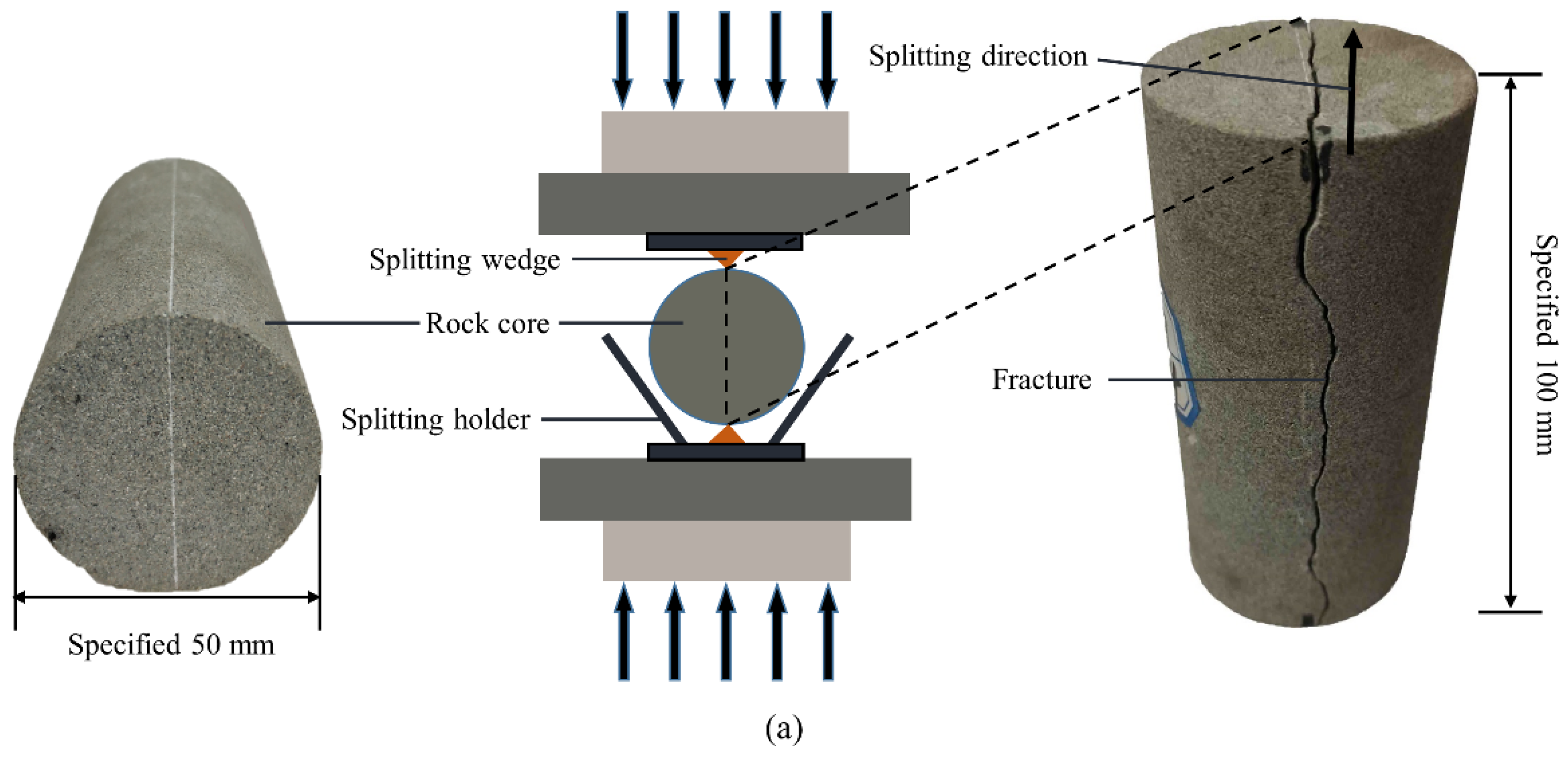


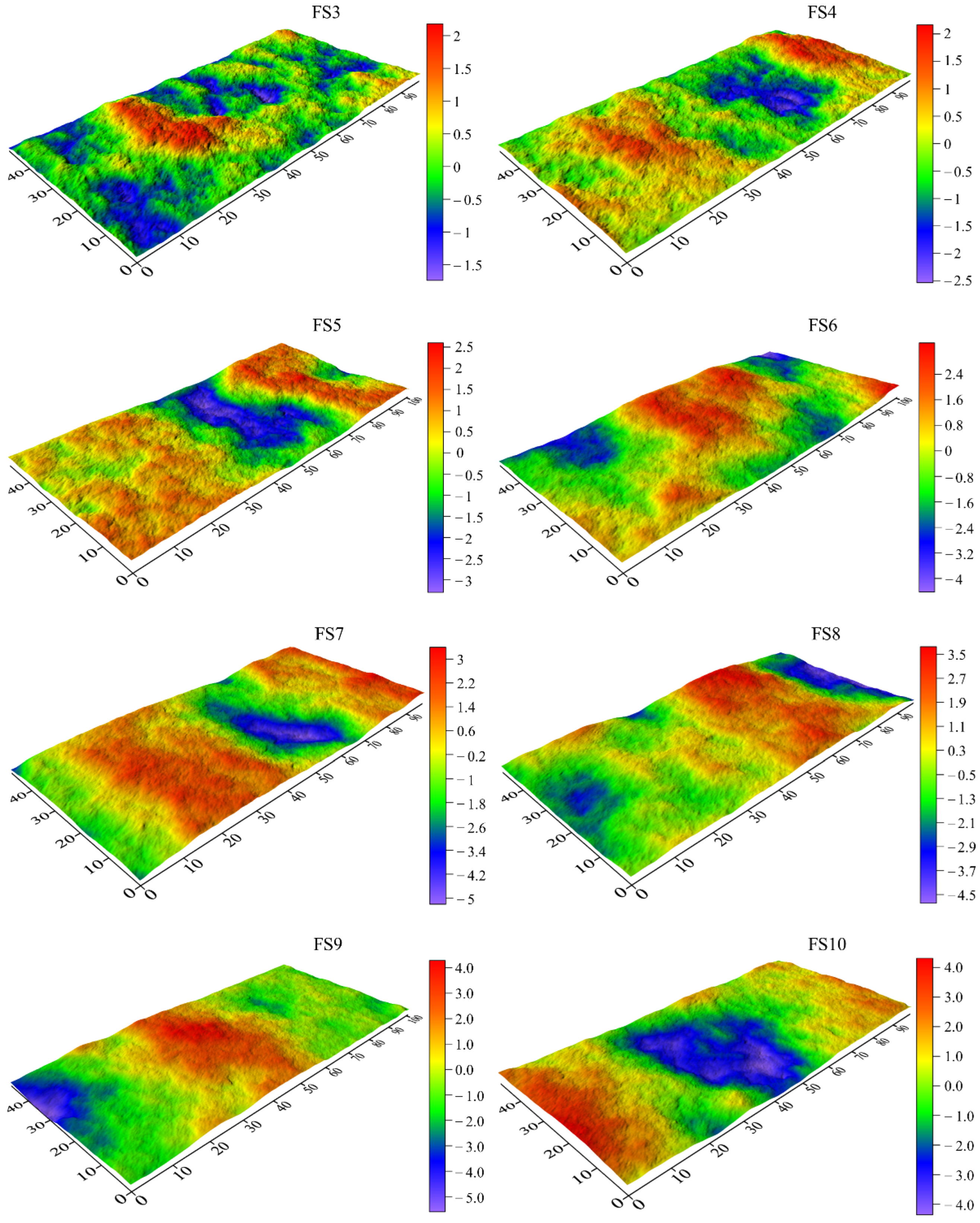
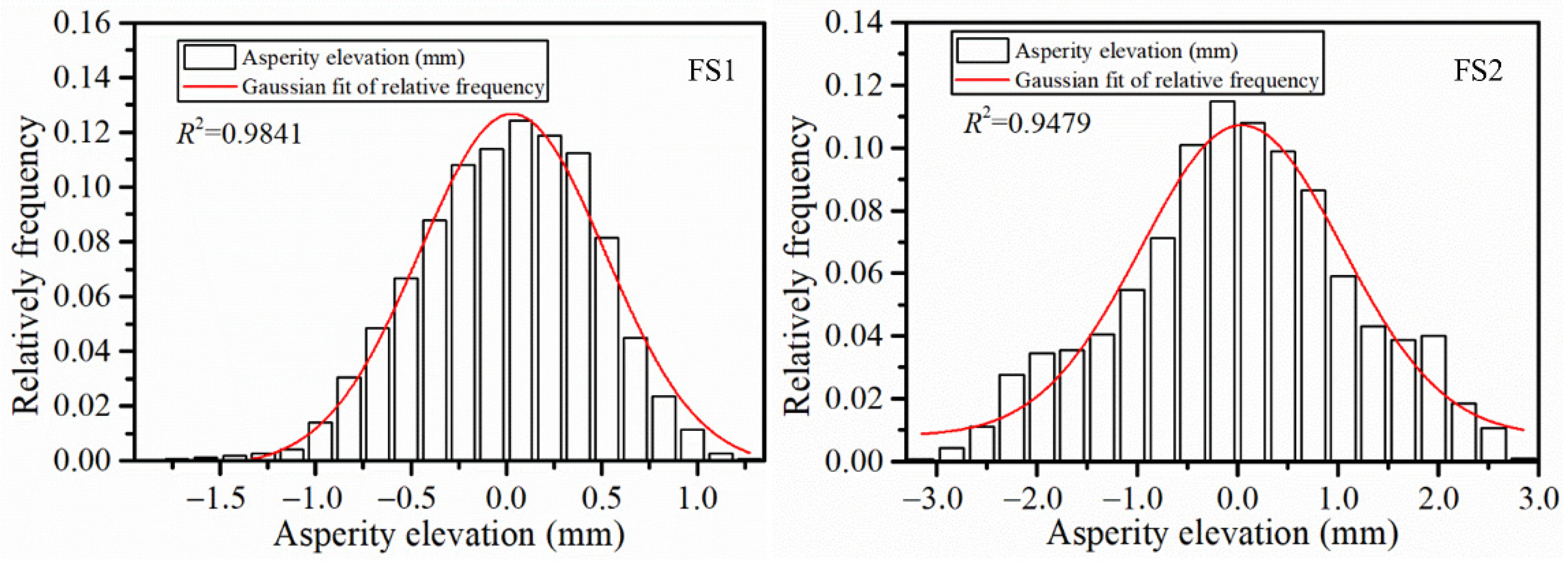



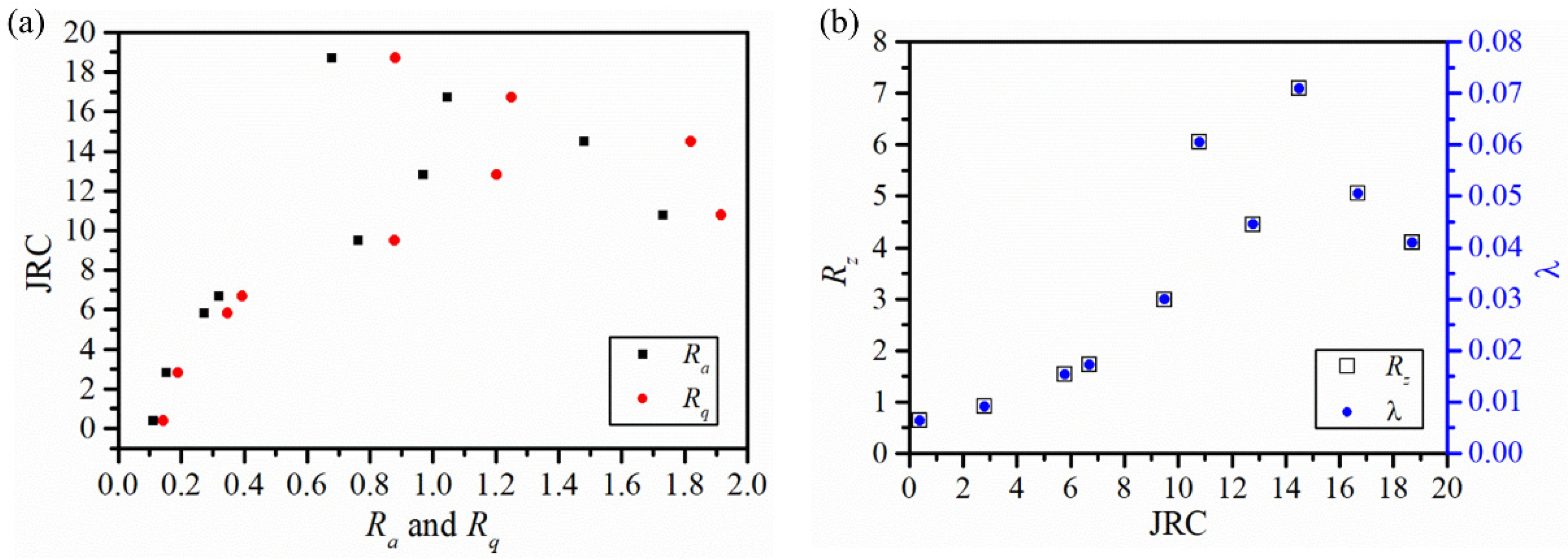

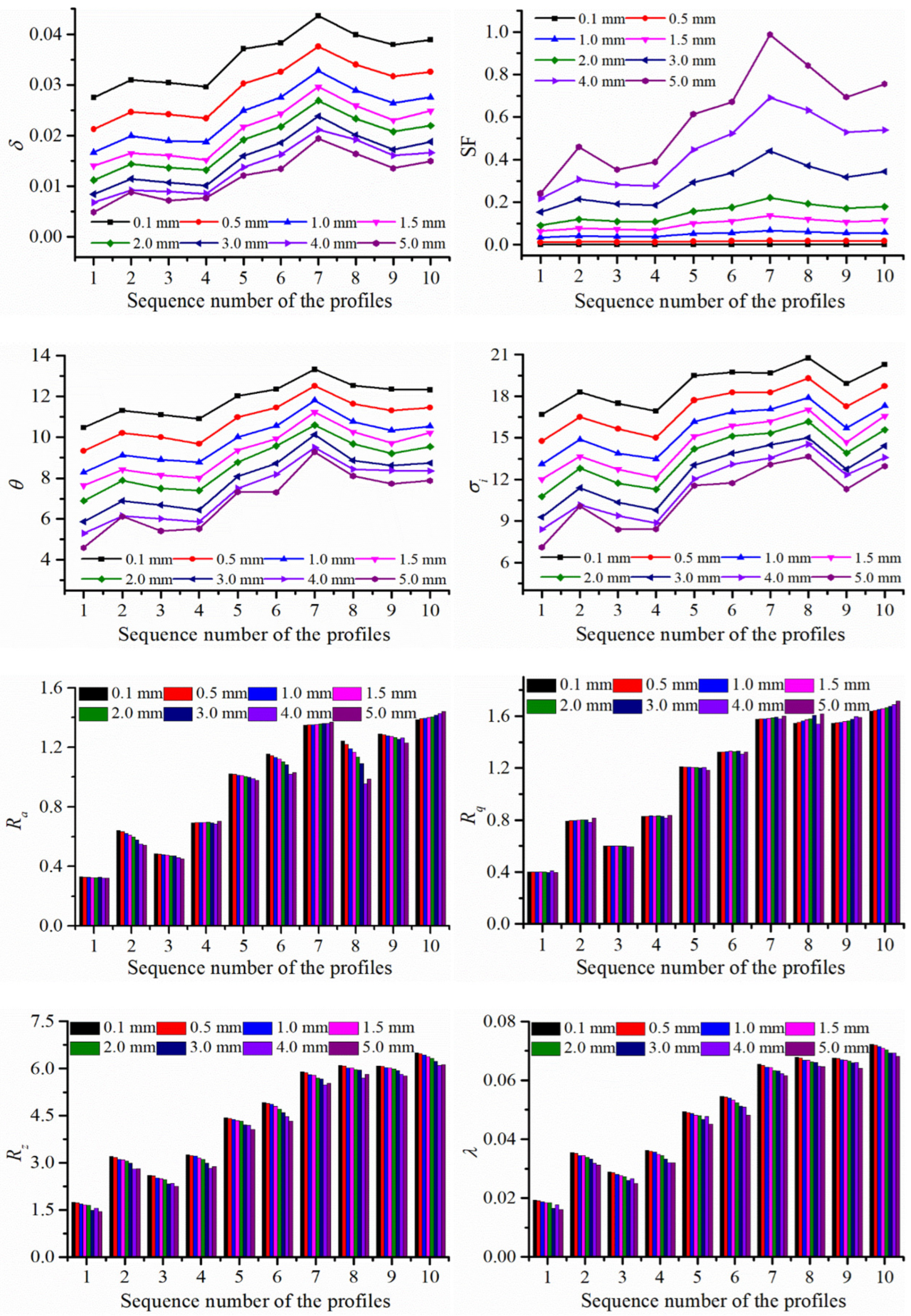
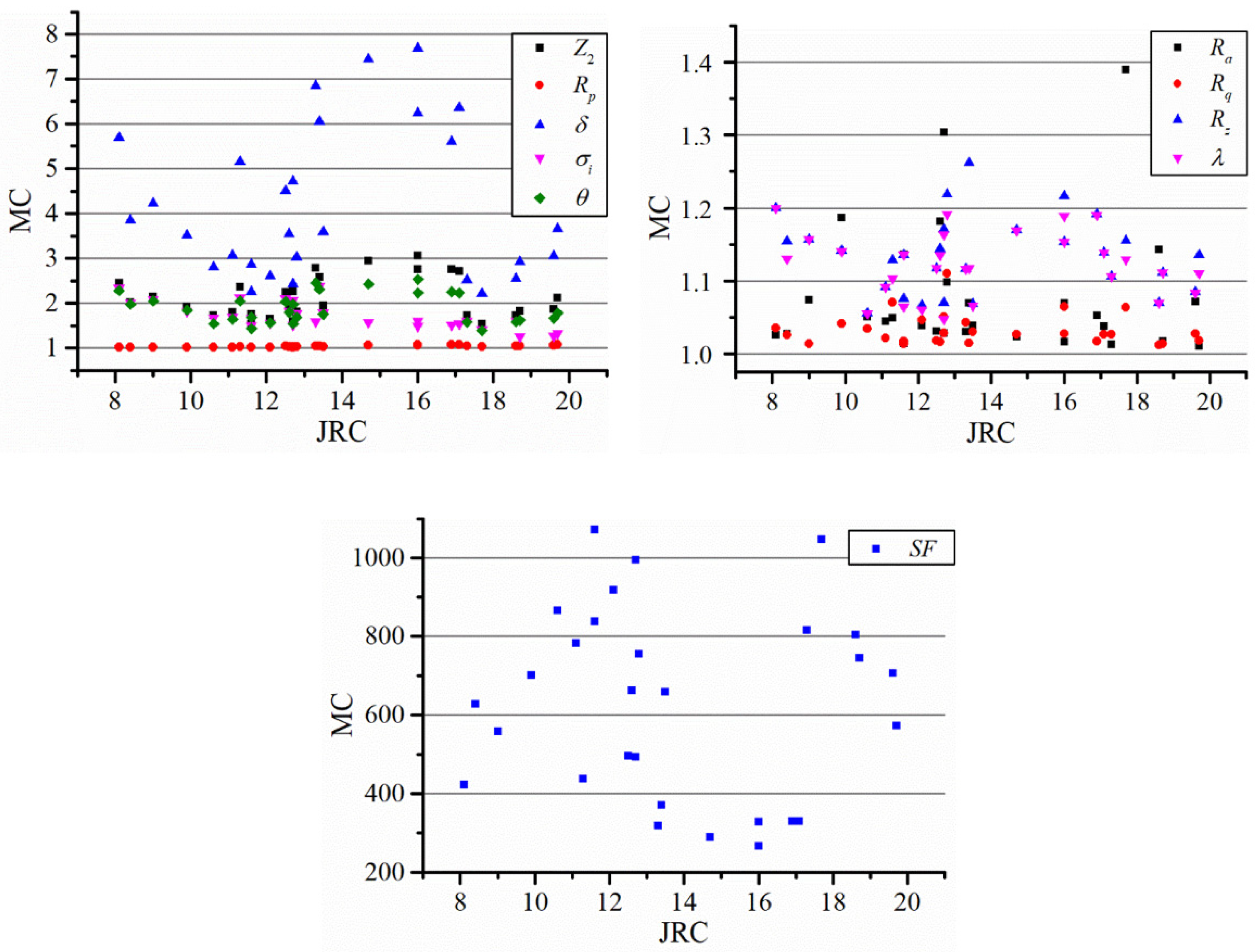

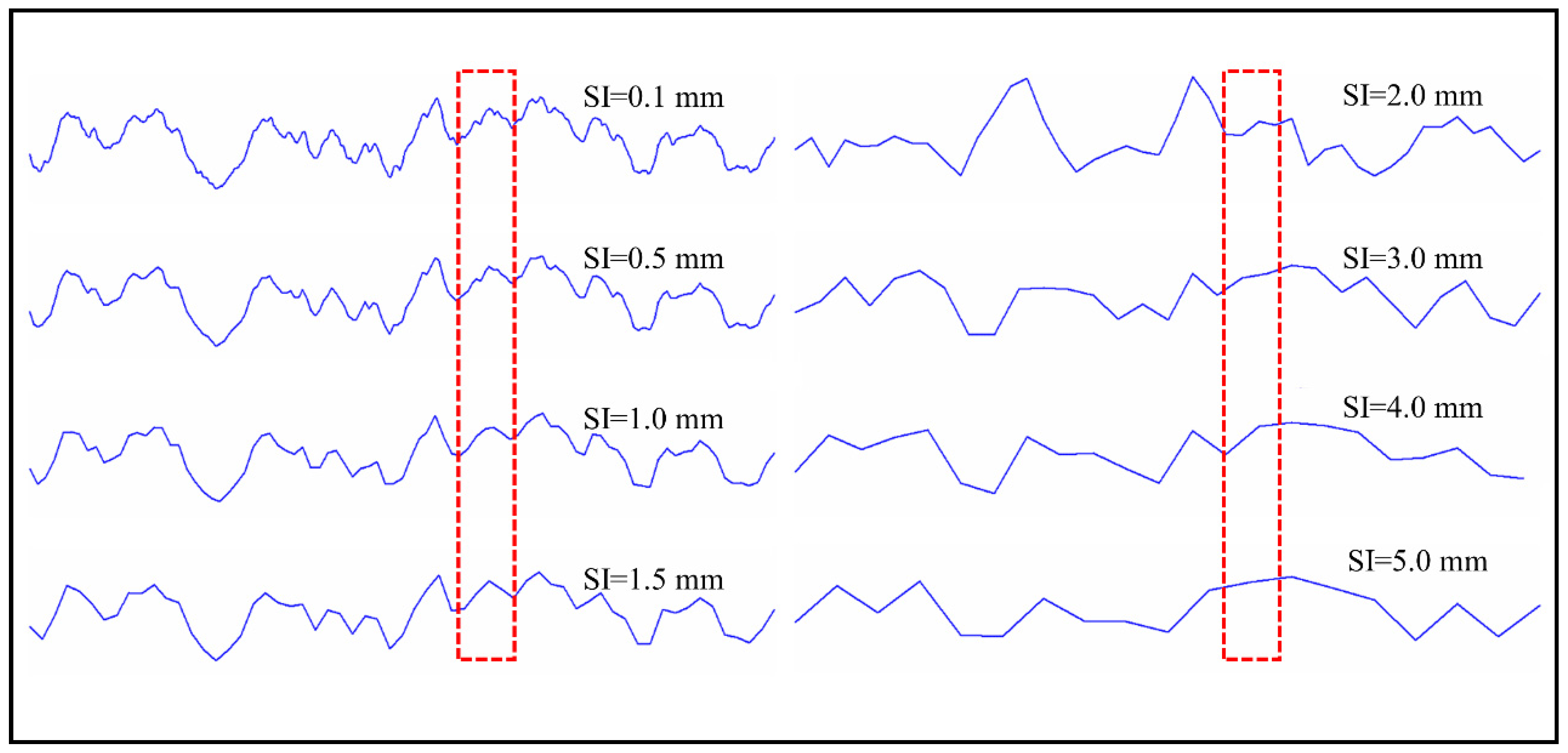
| Profile No. | Rock Type | Typical Roughness Profiles | JRC Back-Calculated |
|---|---|---|---|
| 1 | Slate |  | 0.4 |
| 2 | Aplite |  | 2.8 |
| 3 | Gneiss |  | 5.8 |
| 4 | Granite |  | 6.7 |
| 5 | Granite |  | 9.5 |
| 6 | Hornfels |  | 10.8 |
| 7 | Aplite |  | 12.8 |
| 8 | Aplite |  | 14.5 |
| 9 | Hornfels |  | 16.7 |
| 10 | Soapstone |  | 18.7 |
 | |||
| No. | Variable | Equation | R2 | Rang# |
|---|---|---|---|---|
| E5 | Z2 | 0.9577 | 0.1220–0.4036 | |
| E6 | SF | 0.8790 | 0.0037–0.0409 | |
| E7 | Rp−1 | 0.8956 | 0.0073–0.0718 | |
| E8 | θ | 0.9807 | 3.6151–15.1640 | |
| E9 | δ | 0.9006 | 0.0073–0.0718 |
| Sample No. | JRC Calculated by σi | |||
|---|---|---|---|---|
| Equation (1) | Equation (2) | Equation (3) | Equation (4) (This Study) | |
| FS1 | 12.9 | 10.6 | 14.4 | 8.1 |
| FS2 | 14.9 | 12.4 | 15.7 | 9.9 |
| FS3 | 14.0 | 11.6 | 15.1 | 9.0 |
| FS4 | 13.2 | 10.9 | 14.6 | 8.4 |
| FS5 | 16.3 | 13.7 | 16.5 | 11.1 |
| FS6 | 17.0 | 14.3 | 16.9 | 11.6 |
| FS7 | 16.9 | 14.3 | 16.9 | 11.6 |
| FS8 | 18.1 | 15.4 | 17.5 | 12.7 |
| FS9 | 15.8 | 13.3 | 16.3 | 10.6 |
| FS10 | 17.5 | 14.8 | 17.2 | 12.1 |
| CS1 | 19.0 | 16.2 | 17.9 | 13.4 |
| CS2 | 16.6 | 13.9 | 16.7 | 11.3 |
| CS3 | 18.1 | 15.4 | 17.5 | 12.7 |
| CS4 | 18.0 | 15.3 | 17.4 | 12.6 |
| CS5 | 19.1 | 16.3 | 18.0 | 13.5 |
| CS6 | 24.9 | 21.6 | 20.3 | 18.6 |
| CS7 | 18.3 | 15.5 | 17.6 | 12.8 |
| CS8 | 23.9 | 20.6 | 19.9 | 17.7 |
| CS9 | 23.4 | 20.2 | 19.7 | 17.3 |
| CS10 | 17.7 | 15.0 | 17.3 | 12.3 |
| GR1 | 23.0 | 19.8 | 19.6 | 16.9 |
| GR2 | 22.0 | 18.9 | 19.2 | 16.0 |
| GR3 | 20.5 | 17.5 | 18.6 | 14.7 |
| GR4 | 21.9 | 18.9 | 19.2 | 16.0 |
| GR5 | 18.9 | 16.1 | 17.8 | 13.3 |
| GR6 | 26.3 | 22.9 | 20.7 | 19.8 |
| GR7 | 25.0 | 21.7 | 20.3 | 18.7 |
| GR8 | 23.2 | 20.0 | 19.6 | 17.1 |
| GR9 | 26.3 | 22.9 | 20.7 | 19.8 |
| Sample No. | SF | Z2 | ||||
|---|---|---|---|---|---|---|
| A | B | R2 | A | B | R2 | |
| FS1 | 0.0426 | 1.1156 | 0.9851 | 0.1659 | −0.1862 | 0.8517 |
| FS2 | 0.0406 | 1.4970 | 0.9975 | 0.1874 | −0.1564 | 0.8935 |
| FS3 | 0.0449 | 1.2963 | 0.9970 | 0.1802 | −0.1694 | 0.8769 |
| FS4 | 0.0386 | 1.4321 | 0.9996 | 0.1794 | −0.1657 | 0.8893 |
| FS5 | 0.0562 | 1.4893 | 0.9997 | 0.2136 | −0.1371 | 0.9029 |
| FS6 | 0.0672 | 1.4452 | 0.9967 | 0.2228 | −0.1245 | 0.8693 |
| FS7 | 0.0729 | 1.6212 | 0.9998 | 0.2483 | −0.1036 | 0.9013 |
| FS8 | 0.0656 | 1.5973 | 0.9977 | 0.2334 | −0.1109 | 0.9114 |
| FS9 | 0.0602 | 1.5307 | 0.9976 | 0.2202 | −0.1272 | 0.9034 |
| FS10 | 0.0612 | 1.5638 | 0.9998 | 0.2260 | −0.1206 | 0.9055 |
| CS1 | 0.0719 | 1.2107 | 0.9943 | 0.2288 | −0.2133 | 0.9367 |
| CS2 | 0.0452 | 1.4341 | 0.9983 | 0.2012 | −0.2092 | 0.9645 |
| CS3 | 0.0622 | 1.3678 | 0.9963 | 0.2224 | −0.1897 | 0.9464 |
| CS4 | 0.0680 | 1.4151 | 0.9944 | 0.2268 | −0.1530 | 0.9313 |
| CS5 | 0.0737 | 1.4222 | 0.9989 | 0.2400 | −0.1547 | 0.9252 |
| CS6 | 0.1662 | 1.4621 | 0.9949 | 0.3479 | −0.1251 | 0.9143 |
| CS7 | 0.0718 | 1.5797 | 0.9998 | 0.2537 | −0.1480 | 0.9543 |
| CS8 | 0.1105 | 1.6560 | 0.9999 | 0.3098 | −0.1067 | 0.9385 |
| CS9 | 0.1329 | 1.5127 | 0.9959 | 0.3178 | −0.1285 | 0.9096 |
| CS10 | 0.0610 | 1.4574 | 0.9999 | 0.2322 | −0.1958 | 0.9695 |
| GR1 | 0.0799 | 1.3361 | 0.9994 | 0.2659 | −0.2434 | 0.9472 |
| GR2 | 0.0721 | 1.2827 | 0.9991 | 0.2529 | −0.2682 | 0.9682 |
| GR3 | 0.0619 | 1.2564 | 0.9988 | 0.2298 | −0.2545 | 0.9539 |
| GR4 | 0.0653 | 1.3703 | 0.9997 | 0.2457 | −0.2466 | 0.9501 |
| GR5 | 0.0582 | 1.2891 | 0.9996 | 0.2235 | −0.2439 | 0.9518 |
| GR6 | 0.1335 | 1.5721 | 0.9996 | 0.3460 | −0.1540 | 0.9675 |
| GR7 | 0.1147 | 1.5780 | 0.9996 | 0.3160 | −0.1470 | 0.9681 |
| GR8 | 0.0913 | 1.2675 | 0.9950 | 0.2720 | −0.2322 | 0.9490 |
| GR9 | 0.1276 | 1.4815 | 0.9999 | 0.3286 | −0.1832 | 0.9585 |
| Sample No. | Rp | δ | ||||
| A | B | R2 | A | B | R2 | |
| FS1 | 1.0154 | −0.0058 | 0.9716 | 0.0140 | −0.0460 | 0.8681 |
| FS2 | 1.0187 | −0.0059 | 0.9749 | 0.0173 | −0.0341 | 0.8975 |
| FS3 | 1.0176 | −0.0060 | 0.9748 | 0.0166 | −0.0377 | 0.8879 |
| FS4 | 1.0174 | −0.0058 | 0.9751 | 0.0161 | −0.0366 | 0.8931 |
| FS5 | 1.0236 | −0.0064 | 0.9742 | 0.0224 | −0.0286 | 0.9040 |
| FS6 | 1.0254 | −0.0062 | 0.9524 | 0.0247 | −0.0295 | 0.8755 |
| FS7 | 1.0307 | −0.0061 | 0.9602 | 0.0301 | −0.0219 | 0.9011 |
| FS8 | 1.0276 | −0.0059 | 0.9661 | 0.0266 | −0.0224 | 0.9091 |
| FS9 | 1.0251 | −0.0062 | 0.9684 | 0.0239 | −0.0265 | 0.9027 |
| FS10 | 1.0261 | −0.0061 | 0.9673 | 0.0252 | −0.0251 | 0.9027 |
| CS1 | 1.0293 | −0.0122 | 0.9937 | 0.0260 | −0.0354 | 0.9375 |
| CS2 | 1.0231 | −0.0097 | 0.9880 | 0.0204 | −0.0266 | 0.9652 |
| CS3 | 1.0269 | −0.0100 | 0.9927 | 0.0242 | −0.0295 | 0.9450 |
| CS4 | 1.0269 | −0.0081 | 0.9888 | 0.0254 | −0.0261 | 0.9325 |
| CS5 | 1.0300 | −0.0090 | 0.9866 | 0.0275 | −0.0286 | 0.9226 |
| CS6 | 1.0537 | −0.0116 | 0.9745 | 0.0522 | −0.0212 | 0.9219 |
| CS7 | 1.0330 | −0.0096 | 0.9915 | 0.0313 | −0.0204 | 0.9554 |
| CS8 | 1.0471 | −0.0092 | 0.9797 | 0.0453 | −0.0174 | 0.9360 |
| CS9 | 1.0468 | −0.0102 | 0.9684 | 0.0451 | −0.0229 | 0.9114 |
| CS10 | 1.0291 | −0.0110 | 0.9962 | 0.0262 | −0.0219 | 0.9705 |
| GR1 | 1.0396 | −0.0181 | 0.9801 | 0.0366 | −0.0375 | 0.9376 |
| GR2 | 1.0374 | −0.0187 | 0.9807 | 0.0314 | −0.0366 | 0.9574 |
| GR3 | 1.0308 | −0.0150 | 0.9837 | 0.0262 | −0.0404 | 0.9435 |
| GR4 | 1.0344 | −0.0158 | 0.9767 | 0.0298 | −0.0416 | 0.9322 |
| GR5 | 1.0287 | −0.0136 | 0.9841 | 0.0247 | −0.0399 | 0.9402 |
| GR6 | 1.0585 | −0.0166 | 0.9892 | 0.0560 | −0.0196 | 0.9588 |
| GR7 | 1.0494 | −0.0130 | 0.9911 | 0.0467 | −0.0191 | 0.9558 |
| GR8 | 1.0408 | −0.0180 | 0.9838 | 0.0358 | −0.0386 | 0.9356 |
| GR9 | 1.0557 | −0.0177 | 0.9910 | 0.0518 | −0.0265 | 0.9411 |
| Sample No. | θ | σi | ||||
| A | B | R2 | A | B | R2 | |
| FS1 | 7.4943 | −0.1746 | 0.8385 | 11.8211 | −0.1782 | 0.8436 |
| FS2 | 8.4746 | −0.1492 | 0.8738 | 13.8057 | −0.1456 | 0.8815 |
| FS3 | 8.1793 | −0.1591 | 0.8619 | 12.7733 | −0.1624 | 0.8669 |
| FS4 | 8.0267 | −0.1574 | 0.8738 | 12.3054 | −0.1634 | 0.8791 |
| FS5 | 9.4741 | −0.1234 | 0.9018 | 15.2581 | −0.1258 | 0.8989 |
| FS6 | 9.9773 | −0.1142 | 0.8497 | 15.9228 | −0.1146 | 0.8578 |
| FS7 | 11.2573 | −0.0901 | 0.8868 | 16.2786 | −0.0995 | 0.8968 |
| FS8 | 10.2509 | −0.1062 | 0.8858 | 17.1376 | −0.1004 | 0.8987 |
| FS9 | 9.9180 | −0.1113 | 0.9205 | 14.9390 | −0.1211 | 0.9066 |
| FS10 | 10.0920 | −0.1060 | 0.8752 | 16.5286 | −0.1073 | 0.8897 |
| CS1 | 9.8305 | −0.1873 | 0.9003 | 15.8384 | −0.1941 | 0.9173 |
| CS2 | 8.9809 | −0.1792 | 0.9472 | 14.5415 | −0.1850 | 0.9551 |
| CS3 | 9.9470 | −0.1560 | 0.9291 | 15.8793 | −0.1672 | 0.9363 |
| CS4 | 10.1814 | −0.1333 | 0.9081 | 16.3880 | −0.1368 | 0.9174 |
| CS5 | 10.5524 | −0.1309 | 0.8883 | 17.1755 | −0.1363 | 0.9048 |
| CS6 | 12.3624 | −0.1168 | 0.9445 | 22.2406 | −0.1103 | 0.9200 |
| CS7 | 11.3631 | −0.1314 | 0.9366 | 16.4990 | −0.1423 | 0.9471 |
| CS8 | 13.0844 | −0.0851 | 0.9243 | 22.1257 | −0.0868 | 0.9273 |
| CS9 | 11.8134 | −0.1101 | 0.9129 | 21.0558 | −0.1120 | 0.9049 |
| CS10 | 9.9365 | −0.1708 | 0.9566 | 15.7409 | −0.1808 | 0.9602 |
| GR1 | 11.2024 | −0.1981 | 0.9184 | 17.9891 | −0.2136 | 0.9321 |
| GR2 | 10.7387 | −0.2154 | 0.9233 | 17.3103 | −0.2332 | 0.9492 |
| GR3 | 9.9227 | −0.2086 | 0.9103 | 16.3119 | −0.2209 | 0.9354 |
| GR4 | 10.4506 | −0.1922 | 0.9181 | 17.4927 | −0.2068 | 0.9368 |
| GR5 | 9.5644 | −0.2057 | 0.9099 | 15.1834 | −0.2223 | 0.9349 |
| GR6 | 14.5471 | −0.1268 | 0.9331 | 22.7248 | −0.1322 | 0.9526 |
| GR7 | 13.1223 | −0.1144 | 0.9240 | 22.1869 | −0.1190 | 0.9491 |
| GR8 | 11.6967 | −0.1853 | 0.9127 | 18.3945 | −0.2034 | 0.9304 |
| GR9 | 13.6499 | −0.1380 | 0.9143 | 22.2623 | −0.1506 | 0.9398 |
Publisher’s Note: MDPI stays neutral with regard to jurisdictional claims in published maps and institutional affiliations. |
© 2022 by the authors. Licensee MDPI, Basel, Switzerland. This article is an open access article distributed under the terms and conditions of the Creative Commons Attribution (CC BY) license (https://creativecommons.org/licenses/by/4.0/).
Share and Cite
Luo, Y.; Wang, Y.; Guo, H.; Liu, X.; Luo, Y.; Liu, Y. Relationship between Joint Roughness Coefficient and Statistical Roughness Parameters and Its Sensitivity to Sampling Interval. Sustainability 2022, 14, 13597. https://doi.org/10.3390/su142013597
Luo Y, Wang Y, Guo H, Liu X, Luo Y, Liu Y. Relationship between Joint Roughness Coefficient and Statistical Roughness Parameters and Its Sensitivity to Sampling Interval. Sustainability. 2022; 14(20):13597. https://doi.org/10.3390/su142013597
Chicago/Turabian StyleLuo, Yong, Yakun Wang, Heng Guo, Xiaobo Liu, Yihui Luo, and Yanan Liu. 2022. "Relationship between Joint Roughness Coefficient and Statistical Roughness Parameters and Its Sensitivity to Sampling Interval" Sustainability 14, no. 20: 13597. https://doi.org/10.3390/su142013597
APA StyleLuo, Y., Wang, Y., Guo, H., Liu, X., Luo, Y., & Liu, Y. (2022). Relationship between Joint Roughness Coefficient and Statistical Roughness Parameters and Its Sensitivity to Sampling Interval. Sustainability, 14(20), 13597. https://doi.org/10.3390/su142013597








